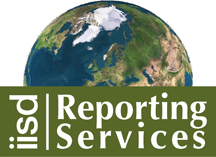News * Abou us * the ENB team * DONATE * Activities * Search * IISD RS home * IISD.org * RSS * What is RSS? * Links |
|
MEA Bulletin
26
September 2006 MEAs: EVOLUTION NOT OSSIFICATION By Mukul Sanwal* The environmental movement has undergone a profound shift since its origins in the middle of the last century. The first phase of this shift, evidenced at the Rio Conference in 1992, was from local concerns to broader stock/flow systemic issues. The current phase, beginning with the Johannesburg Conference in 2002, focuses on ecosystem management and is based on considerations different to those involved in determining policy. Implementation alters the relationship between science and policy, because consensus on principles, which science was instrumental in helping to forge, breaks down in practice. Decision-makers have very different concerns, and the new information to inform public policy will come from science and from practitioners - the impact on other policy arenas; the choices, technologies and forms of organization to be adopted by governments, the private sector and civil society; and through the scaling up of “good practices.” Deliberations within the MEA’s over the last decade have shaped the way the issue is framed, problem solving strategies defined and results evaluated. Instead of describing what could happen, they now seek new approaches for agreement on what should be done. Such a perspective to environmental policy focuses on outlining a desirable goal into the future. These can be strategic policies integrating reduction of emissions of greenhouse gases as a key element of energy policies, announced by the United Kingdom. They can be strategic plans, as in the case of the Convention on Biological Diversity. A recent study advocates re-examination of global biodiversity and forest conservation conventions and mechanisms to ensure that these foster and support community conservation, through new institutional models. As a result of globalization and the recognition that investment, technology and trade are essential means of implementation, the context within which future actions to protect the environment will be undertaken has changed. Environmental policy requires an agreed long-term strategic focus, a set of approaches to understand how to bring about the desired changes, and new forms of collaboration. Technology will be the key driver for change, linking knowledge to action. Since local problems attain global environmental dimensions when they are caused by human impacts whose scale is deep and scope wide, they require strategic and sectoral rather than unit, or project level, technological and institutional change. The strategic nature of such change points to entirely new policy instruments oriented towards partnerships between public and private institutions in research and policy development to galvanize investments and markets. Such a reversal of the conceptual framework requires a focus on institutional innovation and mechanisms for managing change for achieving a consensus on a strategic direction, rather than just on science-based standards or targets. The value added of the United Nations system lies in developing these new perspectives for international cooperation. A fuller version of the paper is available in “What Drives Environment Policy?” in Environment Policy and Law, 36/3-4(2006). |

